aga
Forum Drunkard
    
Posts: 7030
Registered: 25-3-2014
Member Is Offline
|
|
Noticing Things that Happen All the Time
NTHAT for short.
Following a single goal during any procedure tends to blind us to things that happen along the way.
Quantum/Carbon dots were discovered because some one noticed them by accident while trying to purify something.
Today i saw this
https://www.youtube.com/watch?v=BQzABbhwlDM
What exactly is the crystalline structure (composition even) of the metal at the shear point ?
I suspect the main body of research has been into how certain metal compositions perform regarding shear torque etc, and the broken test samples just
got thrown in the bin.
The broken metal edges may well contain some magic never seen before.
Prince Rupert is unlikely to have calculated the super-complex stress characteristics of soda glass before melting some and dropping it into water.
https://en.wikipedia.org/wiki/Prince_Rupert%27s_Drop
|
|
|
SWIM
National Hazard
   
Posts: 970
Registered: 3-9-2017
Member Is Offline
|
|
Quote: Originally posted by aga  |
Today i saw this
https://www.youtube.com/watch?v=BQzABbhwlDM
What exactly is the crystalline structure (composition even) of the metal at the shear point ?
I suspect the main body of research has been into how certain metal compositions perform regarding shear torque etc, and the broken test samples just
got thrown in the bin.
The broken metal edges may well contain some magic never seen before. |
I wouldn't bet on that. Materials engineering is a very sophisticated science, and a lot bigger field than one might think.
I would wager that those fractured metals have been examined pretty much every way I've ever heard of and several I haven't.
EDIT:
Of course, that doesn't mean somebody still won't find some new thing in there by looking at it the right way, or with the right equipment.
Sometimes the magic isn't so much in the data as in the nature of the mind that analyzes it.
[Edited on 29-10-2017 by SWIM]
|
|
|
CharlieA
National Hazard
   
Posts: 646
Registered: 11-8-2015
Location: Missouri, USA
Member Is Offline
Mood: No Mood
|
|
Quote: Originally posted by SWIM  |
Sometimes the magic isn't so much in the data as in the nature of the mind that analyzes it.
[Edited on 29-10-2017 by SWIM] |
SWIM: Well said!!!
|
|
|
Melgar
Anti-Spam Agent
    
Posts: 2004
Registered: 23-2-2010
Location: Connecticut
Member Is Offline
Mood: Estrified
|
|
Quote: Originally posted by aga  | | What exactly is the crystalline structure (composition even) of the metal at the shear point ? |
The same as it is throughout the metal. That SWIM guy is right, and the unlucky fellow who had to take multiple courses on the chemistry of steel was
me. Such is life, when you're an engineering major, just because of how ubiquitous steel is in everything. Anyway, there are mostly two different
crystalline structures of iron that form in steel, martensite and austenite. Martensite is harder and more brittle of the two, and forms in large
amounts when steel is cooled quickly:
https://en.wikipedia.org/wiki/Martensite
https://en.wikipedia.org/wiki/Austenite
What you're seeing in the fracture patterns is the difference between the plastic-deformed grains, and the grains that have only been stretched along
a single axis. Steel fails in a very convenient way, actually. As soon as it exceeds its yield strength (the point where you've bent it enough that
it won't bend back all the way on its own), all of the energy that's being put into it goes towards deforming it. That way, there isn't this enormous
amount of kinetic energy that's released as soon as it fails, like there is with say, glass. A failing steel rod will just start to "neck" at one
point, and then just snap, with barely any noise. The pattern that's visible is the grain boundaries in the steel, which is where it tends to
fracture when it finally does fail.
Disclaimer: I haven't had to use some of this terminology in over a decade, so I may be using some of it incorrectly. However, this is a concept that
I otherwise do understand pretty well.
edit: The reason it fractures at grain boundaries is because of the intermetallic compound Fe3C that forms there, which is brittle. That's also one
reason that the color appears to be different there.
[Edited on 10/30/17 by Melgar]
The first step in the process of learning something is admitting that you don't know it already.
I'm givin' the spam shields max power at full warp, but they just dinna have the power! We're gonna have to evacuate to new forum software!
|
|
|
aga
Forum Drunkard
    
Posts: 7030
Registered: 25-3-2014
Member Is Offline
|
|
Superb information Melgar.
So the surface revealed at the shear-plane should be very high in Fe3C.
Thank you.
|
|
|
Fulmen
International Hazard
    
Posts: 1716
Registered: 24-9-2005
Member Is Offline
Mood: Bored
|
|
Actually there are 3 main phases/structures in steel. In plain non-tempered steel you also have pearlite, a two-phase structure of almost pure iron
and cementite (Fe3C).
The composition of the shear plane won't differ from the rest of the part, but it will reveal the grain structure and fracture mode.
And while tests differ many include examination of fractured surfaces. So in this case you've kicked in an open door, but at least your instincts were
right.
We're not banging rocks together here. We know how to put a man back together.
|
|
|
aga
Forum Drunkard
    
Posts: 7030
Registered: 25-3-2014
Member Is Offline
|
|
Today i did a bit of experimenting with hydrogen generation via basic electrolysis, mostly to establish a baseline before experimenting with different
electrode materials.
At the end, i noticed what i must have seen, and ignored, thousands of times before - bubbles on the glass and on the plastic output pipe i had stuck
in a jar of water (so the H2 being made could be seen/captured).
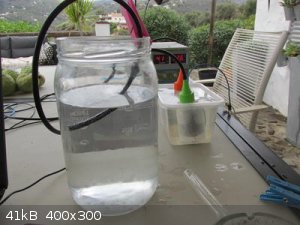 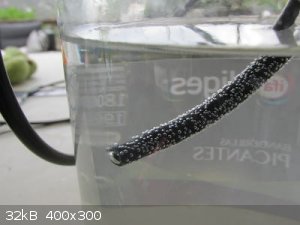
After finishing the first experiment, some other materials were put into the jar of water for 30 minutes to see if any collected (generated ?) bubbles
of gas, namely a strip of Al kitchen foil, a strip of cardboard packaging (for Grissini), some cling-film and a fresh piece of the plastic pipe that
was used earlier.
After immersion the material was tapped a few times to free any air bubbles introduced by the immersion, then left for 30 minutes.
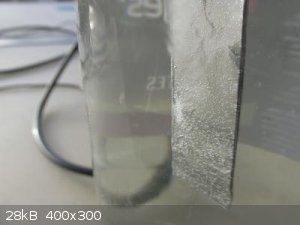  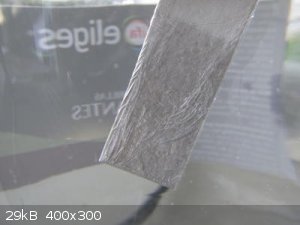 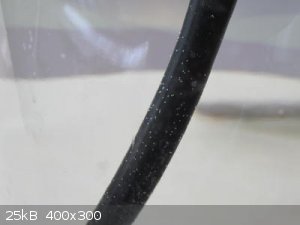
The Al foil showed bubbles only on the lower/reverse side (it was at an angle), despite each side being the same surface of the sheet of foil used.
The cardboard packaging showed bubbles on the printed (presumably plastic coated) side and none on the plain cardboard side.
The cling film did not show any bubbles at all after 30 minutes.
The plastic pipe showed bubbles all over, but smaller after the 30 minute experiment than was seen after the hour-and-a-half H2 experiment.
That suggests (to me at least) that the process is ongoing. A chemical reaction with the pipe is unlikely as it is irrigation pipe, and the liquid is
plain tap water.
Anyone got a clue what is happening here ?
|
|
|
LearnedAmateur
National Hazard
   
Posts: 513
Registered: 30-3-2017
Location: Somewhere in the UK
Member Is Offline
Mood: Free Radical
|
|
I think it's just oxygen bubbles (hydrogen too if it can form a strong enough dipole to dissolve in water, which I'm guessing it can to some extent)
coming out of solution, I doubt there's an actual chemical reaction going on. The cloudy solution points to microscopic bubbles floating around which
adhere to certain surfaces, particularly underside considering their buoyancy, and collect further bubbles which causes them to grow to a resolvable
size.
In chemistry, sometimes the solution is the problem.
It’s been a while, but I’m not dead! Updated 7/1/2020. Shout out to Aga, we got along well.
|
|
|
aga
Forum Drunkard
    
Posts: 7030
Registered: 25-3-2014
Member Is Offline
|
|
I thought it might be dissolved oxygen 'coming out' too.
The water is actually clear, just there is still a label on the back of the jar, and the (slightly unclean) glass was in direct sunlight.
The reverse-side/buoyancy thing makes sense, but not for the plastic pipe, where bubbles formed all over the circumference.
What is puzzling is that the bubbles form at all and why at certain sites on different materials, yet not on others.
|
|
|
LearnedAmateur
National Hazard
   
Posts: 513
Registered: 30-3-2017
Location: Somewhere in the UK
Member Is Offline
Mood: Free Radical
|
|
Yeah, I mean the water will be saturated with gas so it'll deposit at any nucleation site available, a bit like champagne really. Ah okay, that would
explain it, it's just that I've done reactions involving gaseous products and sometimes the bubbles will sit in a somewhat stable layer, being too
small to float to the surface and it looks somewhat like the water in the jars. I guess it depends on what the pipe is made of and how coarse it is -
as opposed to smooth cling film, the matte surface permits adhesion of the bubbles past blocking their upward journey, that's what I think anyway. The
cardboard might not do this because it absorbs water, that seems to be the only difference between the materials but I can't say conclusively on that
matter.
In chemistry, sometimes the solution is the problem.
It’s been a while, but I’m not dead! Updated 7/1/2020. Shout out to Aga, we got along well.
|
|
|
karlos³
International Hazard
    
Posts: 1520
Registered: 10-1-2011
Location: yes!
Member Is Offline
Mood: oxazolidinic 8)
|
|
I noticed that every breath I take, I only absorb a few percent of oxygen instead of the whole contained in the air.
Also, to never leave stop-cocks assembled ever.
Oh, and I learned that yeast immobilisation in montmorrilonite is quite cool compared to alginate, I love it!
|
|
|
NEMO-Chemistry
International Hazard
    
Posts: 1559
Registered: 29-5-2016
Location: UK
Member Is Offline
Mood: No Mood
|
|
Quote: Originally posted by karlos³  | I noticed that every breath I take, I only absorb a few percent of oxygen instead of the whole contained in the air.
Also, to never leave stop-cocks assembled ever.
Oh, and I learned that yeast immobilisation in montmorrilonite is quite cool compared to alginate, I love it! |
I used alginate before but not the other, what differences are you getting?
As for the pipe thing, take a look at electron micrographs of pipe, its like a alien landscape, so the nucleation site thing makes sense.
But having said that, it is odd how some sites are 'chosen' and some not.
|
|
|
Melgar
Anti-Spam Agent
    
Posts: 2004
Registered: 23-2-2010
Location: Connecticut
Member Is Offline
Mood: Estrified
|
|
Aluminum foil has a shiny side and a dull side. This is because two sheets of it are pressed between rollers at once, which speeds up the process a
lot. The shiny side was pressed against a roller, and the dull side was pressed against the other sheet of foil. They could make both sides
shiny if they wanted to, but I guess they preferred to inspire a generation of urban legends. And they wanted to save money. Mostly the second one.
The reason that you see bubbles on the underside and not the top of the aluminum is that the buoyancy force of the bubbles pushes them against the
foil if they're on the underside, and away from the foil if they're on the top. This is a pretty big factor in determining whether they'll separate
from whatever they're on.
A lot of times bubbles will form in weird patterns, but usually that's just from other bubbles rising to the surface and leaving behind big gaps that
are conspicuously absent of bubbles.
For chlorinated water, there could be a reaction with aluminum, exposing its surface and allowing it to react with the water and generate hydrogen.
Hydrogen tends to form the smallest bubbles, then nitrogen, then oxygen, then CO2. With experience, it's surprisingly easy to tell them apart. I
think it has to do with their water solubility; if a gas dissolves well in water, then any tiny bubbles it would form would just dissolve again.
The first step in the process of learning something is admitting that you don't know it already.
I'm givin' the spam shields max power at full warp, but they just dinna have the power! We're gonna have to evacuate to new forum software!
|
|
|
aga
Forum Drunkard
    
Posts: 7030
Registered: 25-3-2014
Member Is Offline
|
|
Odd Shadows
Having a wee today i noticed unusual shadows being cast in the downstairs bathroom.
It has lots of lights above the mirrors, so it is basically an odd shadow due to multiple light sources.
However, it made me wonder how life on a planet with two Suns would develop, most importantly, how they would See things, and experiment.
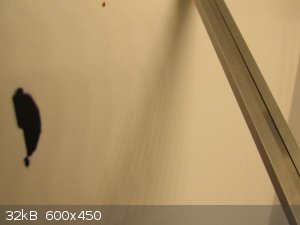

Turned out very hard to get any image at all of the shadows, yet they are very easy to see in real life.
[Edited on 5-12-2017 by aga]
|
|
|
aga
Forum Drunkard
    
Posts: 7030
Registered: 25-3-2014
Member Is Offline
|
|
To make it Clear, having one Sun and one Moon means that we have naturally only One view on reality.
Reality is what it is, no matter who views it, from whatever evolutionary perspective.
So far we have exalted 0 and 1 (Day, Night) to dizzying heights.
Maybe 0, 1 and the newly discovered 2 will take us further.
|
|
|
Melgar
Anti-Spam Agent
    
Posts: 2004
Registered: 23-2-2010
Location: Connecticut
Member Is Offline
Mood: Estrified
|
|
I thought that a binary star system would destabilize its planets' orbits, causing them to be ejected from the star system or crash into each other or
one of the stars, eventually. But it turns out many configurations are stable. All the stable configurations have the stars either very close
together, or very far apart. Here is an artist's conception of the Kepler-47 star system:
https://en.wikipedia.org/wiki/Kepler-47c#/media/File:Artist%...
Usually, one of the stars is a lot brighter than the other. One of the issues with binary systems is that planets have to be further away from the
stars in order to have a stable orbit. Brighter stars can illuminate planets that are further away, but they often burn out in just a few million
years. This would be okay if we were looking for an uninhabited planet to live on though. A few million years is a long time for people.
Earth doesn't just have day and night though. We also have seasons. Imagine a planet just like ours, but that didn't tilt on its axis. They might
not even be able to tell how long a year was. Earth has three natural time cycles as a result: day, lunar month, and year. A planet with no moon and
no axial tilt might only experience changes in day length. And a tidally locked planet (that always has the same side facing the sun, like the moon
is tidally locked to Earth) would not even have days.
I read a science fiction book once, with an inhabited tidally-locked planet, where supposedly all the atmosphere could freeze on the side of the
planet that faced away from the star. This would never actually happen though, because convection cells would form in the atmosphere to transfer heat
from the hot side to the cold side.
The first step in the process of learning something is admitting that you don't know it already.
I'm givin' the spam shields max power at full warp, but they just dinna have the power! We're gonna have to evacuate to new forum software!
|
|
|